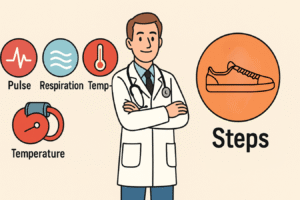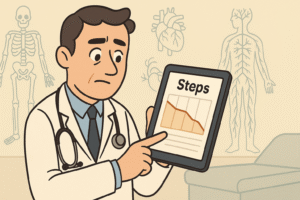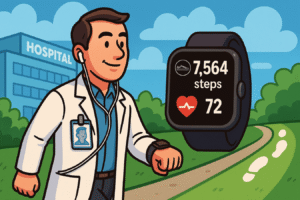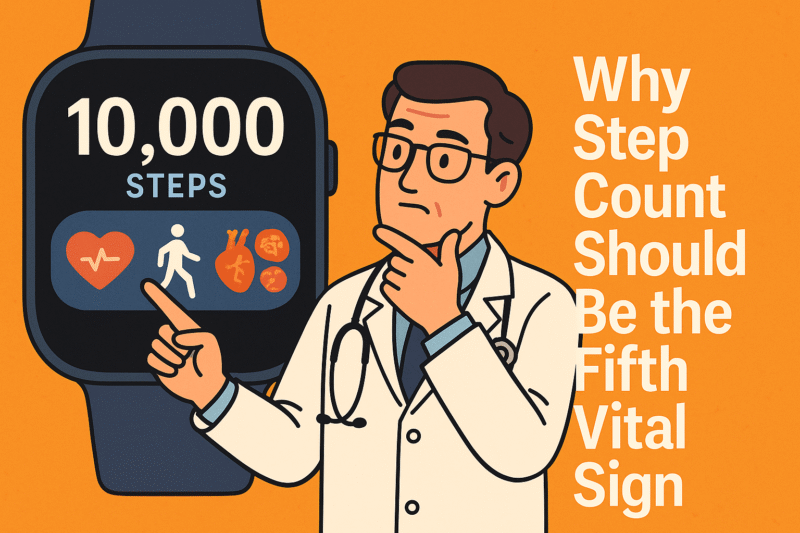The Missing Piece in Modern Health Monitoring
When we talk about vital signs, we usually think of four — pulse, respiration, temperature, and blood pressure. These have guided clinicians for over a century, giving us essential snapshots of a patient’s current physiological state. But as a doctor working abroad and caring for patients across different lifestyles and environments, I’ve realized we’re missing something. It’s time to recognize step count as the fifth vital sign — a simple, objective, and incredibly insightful measure of overall well-being.
Why Step Count Deserves a Place Among the Vital Signs
If we define “vital” as essential to health and life, pulse and breathing still stand at the top. But if we define it as meaningful and decisive to understanding someone’s health and function, daily step count fits right in.
Unlike isolated readings like blood pressure or temperature, step count captures an integrated performance of the entire body. To walk consistently every day, several systems must work together flawlessly — including:
-
Musculoskeletal system: bones, joints, tendons, ligaments
-
Nervous system: brain, spinal cord, sensory and motor nerves
-
Cardiovascular system: heart, vessels, and circulation
-
Vestibular and proprioceptive systems: balance and coordination
A decline in step count can signal subtle dysfunctions in any of these systems long before traditional vital signs show abnormalities.

The Step Count Advantage — Sensitivity Beyond the Clinic
Traditional vital signs often alert us after something goes wrong. Step count, on the other hand, can warn us before symptoms even appear.
Imagine a patient whose step count drops gradually over weeks. They may still look well during a consultation, but their wearable data could reveal early fatigue, joint pain, cardiovascular deconditioning, or even mood decline.
This makes daily steps a sensitive marker of both physical and psychological health. Studies show that higher daily steps are associated with lower all-cause mortality, reduced risk of chronic disease, and improved mental health (CDC).

“But Isn’t Step Count Voluntary?” — The Common Objection
One of the main criticisms is that step count depends on motivation and voluntary action. But as a physician, I see this as a strength, not a flaw.
Our psychological well-being directly influences our activity levels. Fatigue, depression, burnout, or chronic pain often reflect in reduced daily steps. So, instead of disqualifying step count, this connection gives it even greater clinical relevance.
In fact, wearable activity data can reflect early signs of frailty, depression, or reduced motivation, especially in older adults — areas traditional vital signs often miss.
From Wearables to Wellness — Technology Has Caught Up
In the past, tracking movement wasn’t easy or reliable. But today, smartwatches and fitness trackers have made step monitoring remarkably accurate. Devices like the Apple Watch, Fitbit, and Garmin provide continuous, validated data on step counts, heart rate, and activity levels.
These real-world metrics give healthcare providers new tools for preventive medicine. Instead of asking “How active are you?”, we can now review actual numbers. A consistent daily steps above 7,000–10,000 is associated with longer life expectancy (NIH Study).

Step Count as a Reflection of Resilience
Personally, I’ve seen how daily steps reflects not just mobility, but resilience. Whether you’re a young doctor working 12-hour shifts or a retired professional managing chronic disease, your ability to stay active each day mirrors your physical and mental strength.
In my own practice, patients who monitor their daily steps tend to be more health-conscious, proactive, and mentally resilient. Their motivation to “close their rings” or hit their daily target often translates to better weight control, improved cardiovascular fitness, and even enhanced sleep quality.
A Call for a New Health Culture
It’s time we expand how we define “vital signs.”
The daily step count isn’t just a fitness trend — it’s a measurable, multi-system health indicator that reflects the harmony between the mind and body.
So the next time you check your heart rate or blood pressure, take a moment to glance at your step count too. It might tell you more about your health than you think.
Key Takeaways
✅ Step count integrates multiple body systems — musculoskeletal, cardiovascular, and neurological.
✅ It provides early sensitivity to physical and psychological changes.
✅ Wearable technology now allows objective tracking in real-world settings.
✅ Step count reflects motivation, mobility, and mental well-being.
✅ It’s time to recognize daily step count as the fifth vital sign.
Final Thoughts
As medicine moves toward personalized and preventive care, step count offers a bridge between clinical observation and everyday behavior. It’s not about hitting 10,000 steps just for a number — it’s about understanding how movement reflects your body’s health, balance, and resilience.









3 comments
I love to read the articles of this website.
Thanks much 👍
Thanks 💕